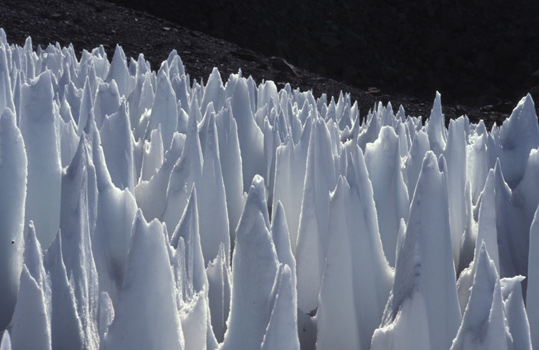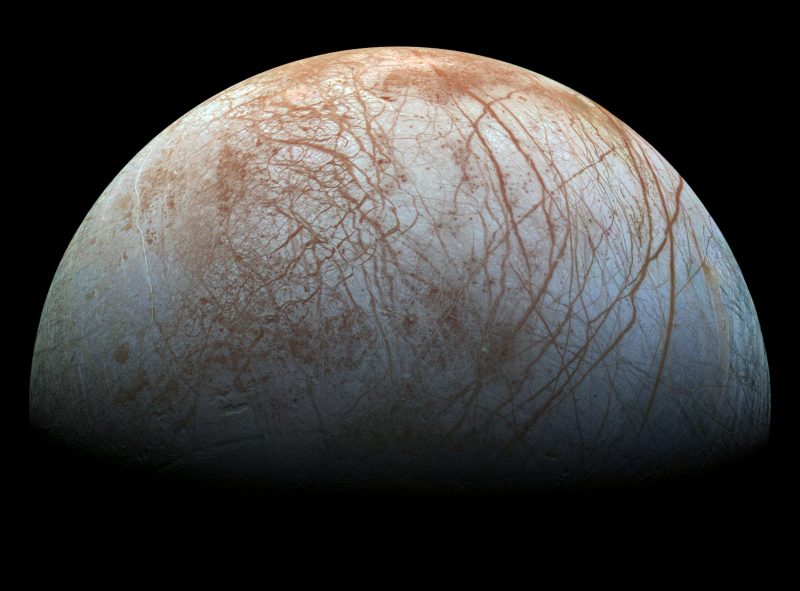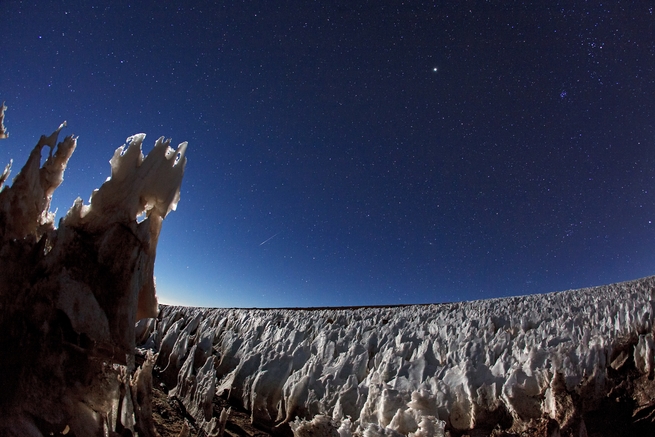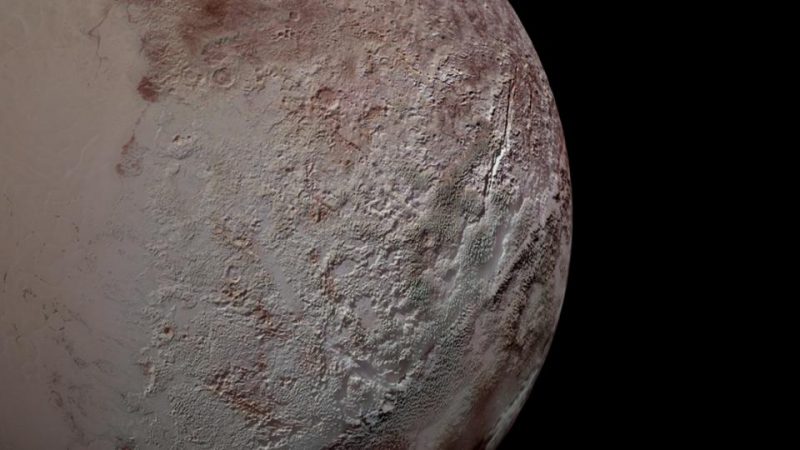
All these worlds are yours – except Europa. Attempt no landings there. So goes the familiar line from the 1982 science fiction novel “2010: Odyssey Two” by Arthur C. Clarke. In it, the artificial intelligence named HAL warns the human astronauts not to try landing on the surface of Jupiter’s moon Europa. Now, as it turns out, landings on Europa might prove difficult in reality – not because of aliens – but because of massive spikes of ice that researchers suspect could be as tall as five-story buildings. The findings were published in the peer-reviewed journal Nature Geoscience on October 8, 2018.
Europa is one of the four famed Galilean satellites of Jupiter. It’s a highly intriguing world, with a possible global ocean beneath an outer shell of ice. Europa’s surface is remarkably smooth for the most part, criss-crossed by many fractures, making the moon look like a giant cracked egg. But the equatorial region seems to be a bit rougher according to the new study, with icy blades likely to be up to 50 feet tall and 23 feet wide (15 meters tall, 7 meters wide) according to new analysis of surface features. They may be similar to formations called penitentes, known on Earth and more recently discovered on Pluto – the “bladed terrain” – by the New Horizons spacecraft in 2015. According to study co-author Orkan Umurhan, an astrophysicist and planetary scientist at NASA Ames Research Center:
It was just a matter of time before we started to imagine that these jagged terrains might exist elsewhere in the solar system.

Penitentes as basically giant blades of ice that are self-oriented toward the sun. In the Atacama Desert in northern Chile, they can be found in areas of bright, sustained sunlight and cold, dry, still air. The sun’s warmth causes ice and snow to sublimate — turn into water vapor without melting first in a process called sublimation. Those ones can grow up to 16 feet tall. As they form, they tend to naturally orient themselves toward the noon-time sun.
Since they are found on Earth and Pluto, the researchers wanted to see if they could also exist on Europa. From the new paper:
On Earth, the sublimation of massive ice deposits at equatorial latitudes under cold and dry conditions in the absence of any liquid melt leads to the formation of spiked and bladed textures eroded into the surface of the ice. These sublimation-sculpted blades are known as penitentes. For this process to take place on another planet, the ice must be sufficiently volatile to sublimate under surface conditions, and diffusive processes that act to smooth the topography must operate more slowly. Here we calculate sublimation rates of water ice across the surface of Jupiter’s moon Europa. We find that surface sublimation rates exceed those of erosion by space weathering processes in Europa’s equatorial belt (latitudes below 23 degrees), and that conditions would favor penitente growth. We estimate that penitentes on Europa could reach 15 meters [50 feet] in depth with a spacing of 7.5 meters [25 feet] near the equator, on average, if they were to have developed across the interval permitted by Europa’s mean surface age. Although available images of Europa have insufficient resolution to detect surface roughness at the multi-meter scale, radar and thermal data are consistent with our interpretation. We suggest that penitentes could pose a hazard to a future lander on Europa.
In order to determine whether they could occur on Europa, the researchers needed to calculate the sublimation rates of water ice across Europa’s surface. These were then compared to meteorite impacts and bombardment from electrically charged particles that hit Europa from Jupiter.

According to their analysis, the sublimation processes would create rougher surface features in the equatorial region of Europa, while other regions would remain smoother – penitentes would nicely explain the radar and thermal anomalies seen previously on this moon of Jupiter. As planetary scientist Cyril Grima at the University of Texas at Austin noted:
It is always pleasant to see how rigorous science can help us imagine how the surface of an unknown planet could be at a scale never observed yet.
The existence of the ice spikes has, at this point, been inferred rather than directly observed, due to the relatively low resolution of the old images from the Galileo probe – still the best images we have right now. Any future probes, such as the upcoming Europa Clipper – which will conduct numerous close flybys of the moon, but not land – will be able to image the surface in much higher resolution. Grima mentioned this also, saying that:
The payload of the upcoming Europa Clipper is perfectly suited for that kind of detection.

That resolution will be needed, since the tall pointed ice spikes could pose a serious hazard to any lander. So how does NASA, or any other space agency, prepare for that possibility? Some other lab tests suggest that there may not be any penitentes on Europa at all. According to Kevin Hand at NASA’s Jet Propulsion Laboratory:
We’ve looked into this problem, and we decided the best thing to do is to just build Europa in the lab. So far, our team has yet to see penitentes form in the lab under conditions comparable to Europa. I’m sure there are strange formations on Europa, but they are not formed by the same physics that drives penitente formation on Earth.
Whether penitentes do indeed exist on Europa isn’t known yet, but it would seem wise for any future lander missions – such as one proposed to follow the Europa Clipper mission – to take the possibility into account. The ones on Pluto for example – while larger – were unexpected, but are definitely real.

The Pluto penitentes are evidence that sublimation can create some bizarre formations throughout the solar system, even on worlds with little or no atmosphere, such as Europa. As Umurhan noted:
It’s becoming apparent that landforms sculpted by sublimation might be pretty widespread among icy bodies in the solar system. When you go to the Atacama Desert and see these, it feels pretty otherworldly, and now we see that really is the case.
Bottom line: If there are penitentes – great spikes of ice – on the surface of Jupiter’s moon Europa, they could make a future landing there difficult. Upcoming space missions, such as Europa Clipper, will survey the surface in much greater detail to find suitable landing sites.
Source: Formation of metre-scale bladed roughness on Europa’s surface by ablation of ice











